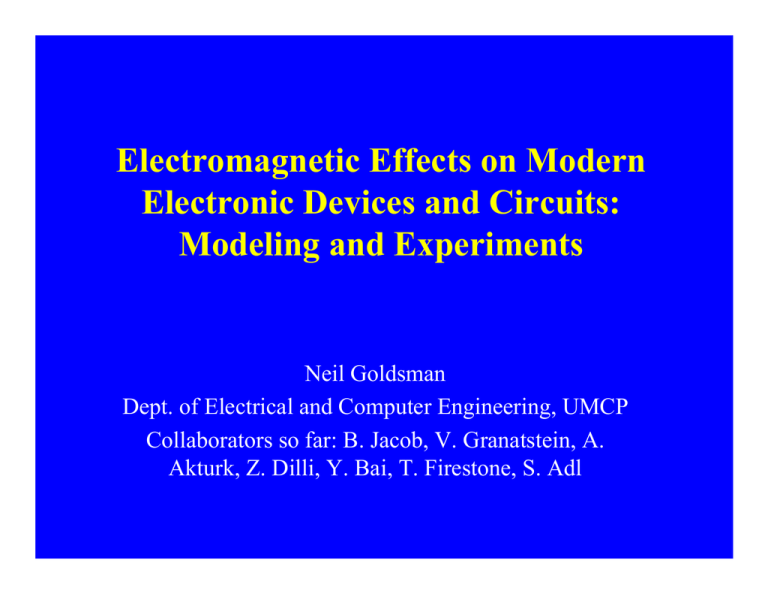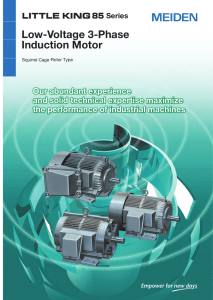Electromagnetic Effects on Modern Electronic Devices and Circuits
advertisement

Electromagnetic Effects on Modern Electronic Devices and Circuits: Modeling and Experiments Neil Goldsman Dept. of Electrical and Computer Engineering, UMCP Collaborators so far: B. Jacob, V. Granatstein, A. Akturk, Z. Dilli, Y. Bai, T. Firestone, S. Adl Outline EM Coupling: Levels Investigated • Device Level (Modeling) • Interconnects and Passive Elements (Modeling) • Circuit Prototyping and Testing for EM Coupling (Experiment) CMOS INVERTER PMOSFET Input NMOSFET Output EM Related Problems in Integrated Circuits Example Chip Task 1: Numerical Modeling & Analysis of EM Effects on Nanoscale Devices Issues: • Chips can contain millions of nanoscale transistors (MOSFETs) • MOSFETs are very fragile, with gate lengths of 0.2µm and below, and oxide thickness of 35Å. • EM pulses can couple to device terminals and alter voltage levels • Such terminal voltage changes can radically alter I-V characteristics and if large enough, can destroy device though oxide breakdown and/or filament formation related to excessive avalanching. Use Numerical Modeling of Nanoscale Devices to help understanding and to predict consequences of EM coupling to terminals, and to present design alternatives for safeguarding against coupling effects. Modeling: Use Detailed Device Modeling to Quantify Transistor Failures (MOSFETs) Oxide MOSFET Cross-Section Gate Length: 0.14µm Oxide Thickness 35Å Doping Profile Solve Transient Semiconductor Device Eqns. Numerically in 2D DD Equations ∇ 2φ = − q ε Si (p − n + D) 1 ∂n = ∇ .J n − R n + G n ∂t q ∂p 1 = − ∇ .J p − R p + G p ∂t q Supplementary DD Equations J n = −qµ n n∇Φ + qµ nVT ∇n J p = − qµ p p∇Φ − qµ pVT ∇p Coupled Discretized DD Equations are solved at each mesh point Results give I-V and Potential, Charge Concentrations, Current Densities inside device. Resulting Electrostatic Potential inside 0.14µm MOSFET: Bias Conditions for Oxide Breakdown VG=2.8V VD=1.4V VS=VB=0V If |Ey| > 7MV/cm => Oxide Breakdown Device Simulations predicts induced gate voltage of 2X supply causes MOSFET oxide damage Distributed Circuit Simulations (Inverter) DD Equations ∇ 2φ = − q ε Si (p − n + D) 1 ∂n = ∇ .J n − R n + G n ∂t q ∂p 1 = − ∇ .J p − R p + G p ∂t q Supplementary DD Equations J n = −qµ n n∇Φ + qµ nVT ∇n J p = − qµ p p∇Φ − qµ pVT ∇p Coupled Discretized DD Equations are solved at each mesh point CMOS Inverter (CMI) Lumped KCL equation check at the output node and using the KCL equation, the output guess is updated for the next iteration, VOi+1: IDN −IDP+IRL +ICL =0 Voi+1 −VSS Voi+1 −Voi AN +B V + AP +B V + +CL =0 RL ∆t i+1 N o i+1 P o RLCL −(AN + AP)RL ∆t Voi+1 = RC 1+ L L +(BN +BP)RL ∆t VSS +Voi Inverters with Different Gate Lengths: Simulated Response to 60psec Pulse Input Input Output Devices scaled according to design rules. For 0.10µm: tox=25Å Dsub=5x1017cm-3 VDD=1.0V W=20µm Response of 0.14µm Physical Gate Length Inverters to Pulses of Different Durations Induced pulse durations greater than 15psec cause upset Vin Vout Current vs Time Voltage vs Time Following animations shows time-dependent solution of CMOS charge transfers of inverters with following voltage responses Vin Vout Voltage vs Time Task 2. Interconnects and Passive Elements Calculation of the Induced Voltage on Passive Elements (Interconnects, Inductors, etc.) • • Stage 1: Static Coupling Approximation Stage 2: Incorporate with Device and Circuit Simulators A Typical Bus allows one Write and certain number of Reads through a single line while the remaining connections are kept in high Impedance or floating states. Interconnect DC Coupling Simulation We developed a simulation tool to find the induced voltages on the floating metals due to the pins tied up to a fixed voltage source in an arbitrary rectangular geometry. ∇ 2Φ = 0 2 ∂ 2Φ x ∂ Φ y ∂ 2Φ z + + =0 2 2 2 ∂x ∂y ∂z ∫ρ V V dV = ∫ ρ S dS = 0 S ρ S = ε Ins EIns − ε Met EMet = ε ins EIns Φ M = VApplied Net Charge is zero inside the metals and the insulator that is filling the region between the metals Total charge concentration on the floating metals is zero The potential is constant for the fixed metals DC Coupling: 2D Simulation Result Here, there are 36 metals uniformly distributed on our mesh grid. The voltages on the two metals at the opposite corners are set to 0 and 10V, and the rest is left to float. Potential Distribution Capacitances In Multiconductor Systems Q1 = C11V1 + C12V2 + ... + C1NVN Q2 = C21V1 + C22V2 + ... + C2 NVN : The relation between potential and charge is linear QN = C N 1V1 + C N 2V2 + ... + C NNVN C ji = Qi Vi V j =0, j ≠i C11 C ⇒ C = 21 : C N 1 C12 ... C 22 ... CN 2 ... C1 N C1 N : C NN By LU decomposition, we find the voltages on the floating metals, (VF1-VFL), using the C matrix and the voltages of the fixed metals, (VM1-VMM). CF1F1VF1 + CF1F2VF2 +...+ CF1FLVFL = −CM1M1VM1 − CM1M2VM2 −...− CM1VMM CF2F1VF2 + CF2F2VF2 +...+ CF2FLVFL = −CM2M1VM1 − CM2M2VM2 −...− CM2VMM : CFLF1VF1 + CFLF2VF2 +...+ CFLFLVFL = −CMM M1VM1 − CMM M2VM2 −...− CMM VMM Then, we find the potential distribution by the utilization of the Conjugate Gradient Method. Task 3. Test Circuit Experiments Design and prototype communication-type circuits for experiments on EM coupling. Receiver The receiver receives the signal sent out by the transmitter, downconverts it to intermediate frequency, and demodulates the signal to recover the information. Integrated Testing Circuits Antenna Mixer Matching Network IFA LNA PLL Demodulator Local Oscillator Signal Processor Output Signal Results, 1: Operation in Frequency Domain, III System output IF mixer output IF mixer input Test Circuit Design Test Receiver Layout on-Chip and on-Board Summary • Device simulators have been developed to model effects of EM coupling: Models. • Models indicate induced voltages of approximately 2X supply voltage can damage nanoscale device. • Minimum pulse duration to cause upset calculated. • 15psec for 0.14µm device • Methodology developed for modeling interconnect coupling: Next, couple to Device Simulator and SPICE • Communication test system and circuits being developed with built-in test equipment.



